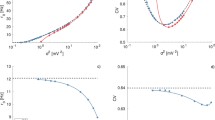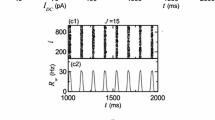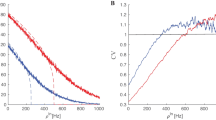Abstract.
Recent experimental results imply that inhibitory postsynaptic potentials can play a functional role in realizing synchronization of neuronal firing in the brain. In order to examine the relation between inhibition and synchronous firing of neurons theoretically, we analyze possible effects of synchronization and sensitivity enhancement caused by inhibitory inputs to neurons with a biologically realistic model of the Hodgkin-Huxley equations. The result shows that, after an inhibitory spike, the firing probability of a single postsynaptic neuron exposed to random excitatory background activity oscillates with time. The oscillation of the firing probability can be related to synchronous firing of neurons receiving an inhibitory spike simultaneously. Further, we show that when an inhibitory spike input precedes an excitatory spike input, the presence of such preceding inhibition raises the firing probability peak of the neuron after the excitatory input. The result indicates that an inhibitory spike input can enhance the sensitivity of the postsynaptic neuron to the following excitatory spike input. Two neural network models based on these effects on postsynaptic neurons caused by inhibitory inputs are proposed to demonstrate possible mechanisms of detecting particular spatiotemporal spike patterns.
Similar content being viewed by others
Author information
Authors and Affiliations
Additional information
Received: 15 April 1999 /Accepted in revised form: 25 November 1999
Rights and permissions
About this article
Cite this article
Luk, W., Aihara, K. Synchronization and sensitivity enhancement of the Hodgkin-Huxley neurons due to inhibitory inputs. Biol Cybern 82, 455–467 (2000). https://doi.org/10.1007/s004220050598
Issue Date:
DOI: https://doi.org/10.1007/s004220050598




